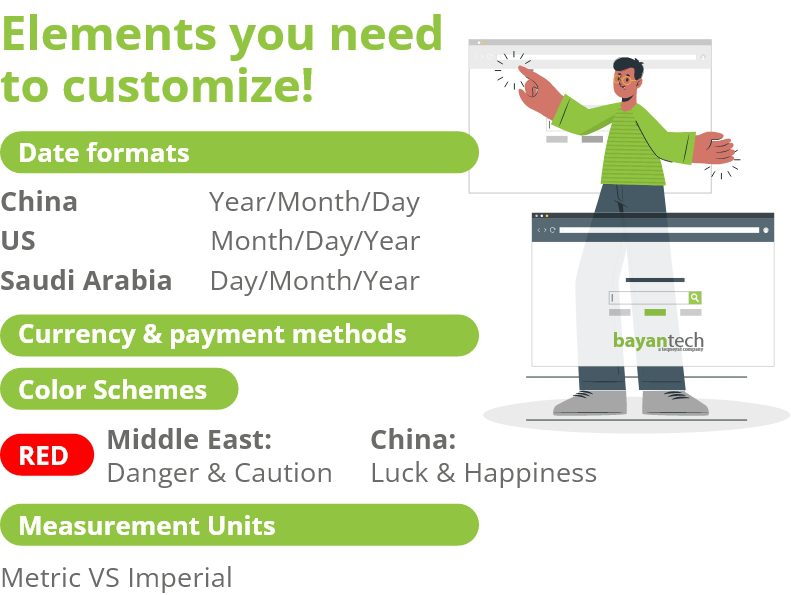Your website opens up your business to customers from every corner of the world. But is it designed to welcome those visitors and keep them engaged?
If your website is in a language they don’t speak and the user experience is not localized for their unique needs and preferences, 40% of international customers won’t buy from your website. And you risk losing +40% of your total market share.
But create a friendly experience for multilingual users, and they will engage, convert, and become your loyal customers. So, how can you do this? By applying website localization best practices.
Today, we’ll walk you through the most effective website localization tips proven to drive real results and take your website internationally without borders.
Your website opens up your business to customers from every corner of the world. But is it designed to welcome those visitors and keep them engaged?
If your website is in a language they don’t speak and the user experience is not localized for their unique needs and preferences, 40% of international customers won’t buy from your website. And you risk losing +40% of your total market share.
But create a friendly experience for multilingual users, and they will engage, convert, and become your loyal customers. So, how can you do this? By applying website localization best practices.
Today, we’ll walk you through the most effective website localization tips proven to drive real results and take your website internationally without borders.
How to Localize a Website (Effectively!)
Website localization refers to adapting a website’s textual and visual content in multiple languages to make it technically and culturally compatible with a specific target audience.
Let’s explore how to adapt your website and maximize your localization impact in 3 key steps!
Understand Your Target Markets
Culture can significantly impact how consumers behave and interact online. It also shapes their preferences, dislikes, and approaches to various digital experiences.
For example, some cultures prefer minimal designs with a clear focus on the product. Whereas, other audiences are more comfortable with context-heavy designs and complex graphics.
Therefore, studying target customers and their culture serves as a roadmap on how to design a truly engaging user experience for each market. To do this, you must perform thorough market research and collect insights on local buying habits, social and cultural norms and expectations, and more.
Tailor Website Content for Each Target Audience
Optimizing your website content and marketing copy to resonate with local audiences is key to attracting potential customers who are searching for the exact product or service you’re offering.
But to localize effectively, you must personalize your content strategy to reflect locally relevant topics and search queries. When you strategically cater to local needs and pain points, visitors are more likely to stay longer on your site, increasing traffic and engagement rates.
Customize Visual & Region-Specific Details
When localizing content, it’s crucial to also adapt visual elements like graphics and colors as well as all region-specific details including currency, date and time, and measurements to match local conventions.
Something as simple as color palettes or symbols can carry great cultural connotations or come off as inappropriate to local users. What’s more, failing to use a payment method or date formats that align with market requirements can confuse, or worse, frustrate customers
This is why you must pay attention to these cultural variations that have a great impact on the user experience and can significantly affect your brand image.
That said, effective localization requires strategic internationalization (i18n). While these are two different processes, they both go hand in hand. So, jump to the next section to understand what i18n is all about!
4 Website Internationalization Best Practices to Make Your Website Ready for Global Audiences
Internationalization is the process of designing a website that can be adapted into various languages and serve your global audience. The goal is to ensure a smooth website localization workflow without requiring difficult engineering changes.
1. Avoid Hardcoding Text Strings
First, you should separate all the content that requires adaptation from the source code. This involves text strings, images, and any other user-facing elements that may differ across locales.
When you keep these translatable elements in special resource files, translators won’t have to modify source codes, consequently minimizing the risk of bugs and errors and making it easier to add more languages efficiently.
2. Implement Right-to-Left (RTL) Support
Optimizing your website to support right-to-left languages, like Arabic and Urdu is vital to providing a comfortable and intuitive experience for users in their native languages.
However, this isn’t just about switching text direction. Instead, you should make sure that every part of your website is accessible and usable in your market’s local languages. As such, you should consider mirroring the entire layout including graphics, buttons, and navigation bars.
3. Use Unicode (UTF-8) When Coding
Next, you should use Unicode which is a universal character encoding system that gives each character a unique number. Using Unicode (UTF-8) ensures that your site’s content is rendered properly, regardless of the alphabet or writing system of your target languages.
This way, your website can seamlessly handle any type of character or symbol from any language, whether it’s English, Spanish, or Chinese, which leaves you assured that content is displayed correctly and is easy to read for multilingual users.
4. Allow Space for Text Expansion
When you translate content from one language to another, the amount of space the text takes up can change. Some languages, like German or Finnish, often have longer words and sentences than English.
For this reason, when designing your website’s interface, you should leave enough space around the text so that when you translate the content, it doesn’t look cramped or cut off.
HTML Localization Best Practices for Improved Search Engine Optimization (SEO)
If local users can’t easily discover your website, then all your efforts would go to waste, right? That’s why you have to optimize your website for local search engines and actively enhance its visibility and ranking.
So, consider these website localization best practices for successful optimization.
Embed Language Attributes
Adding “lang attributes” to your HTML tags enables you to specify the language of each web page. By doing so, search engines can index your content properly and display your localized content for target users. So, users in Spain, for example, will land on your website page that is relevant to their search and is written in Spanish.
Optimize Meta Tags
Customize meta titles and meta descriptions for each localized version of your multilingual website. This is one of the necessary website localization best practices that will significantly boost your SEO ranking.
Use Language-Specific URLs
Consider using language-specific URLs to indicate the language you’re targeting, for example, using (/eg/) for English, (/fr/) for French, and (/es/) for Spanish. This helps search engines understand your site’s content and the region you’re targeting, improving your SEO effectiveness.
Partner Up with Reliable Website Localization Services Professionals
bayantech is a professional language service provider offering comprehensive website localization services in +120 languages. With over 20 years of experience, we’ve built an international team that is fully equipped to adapt your content following the industry’s website localization best practices.
Our services go beyond translation — we assist you at each stage of your website localization strategy. We make sure your website is linguistically accurate, culturally relevant, and technically compatible with your target locale.
Don’t know where to start? Contact us today and let our experts answer all your questions.











